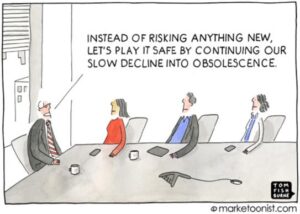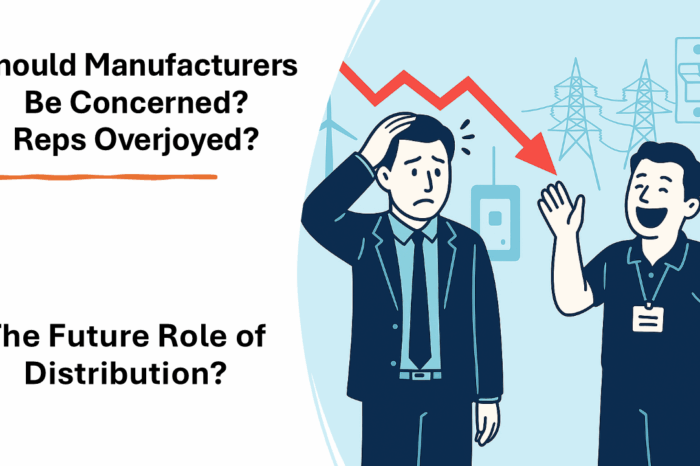Is Today’s Changes Redefining Our Roles?
 Over the past months I have spoken to many dozens of distributors, manufacturers, contractors, and independent manufacturer representatives from various areas of our country getting their views on the changing dynamics of our industry.
Over the past months I have spoken to many dozens of distributors, manufacturers, contractors, and independent manufacturer representatives from various areas of our country getting their views on the changing dynamics of our industry.
The results have been relatively consistent and startling to me, having been in this industry for nearly 50 years. I thought I had lived through various transformations in techniques, services, and functionality, but I believe the changes that are occurring in the industry’s immediate future dwarf much of what I experienced.
Let’s take a look at just a few that affect our direction and warrant immediate consideration as companies consider their future plans.
ELECTRICAL CONTRACTORS
Many are now being paid not by invoice, but by completion of predetermined stages of a project. Existing software programs allow owners, engineers, and general contractors to keep track of phases in a job. In reality, many sub-contractors are unable to bid larger jobs unless they qualify with the required software, enabling all the subs to identify where they are, what is being done and needs to be accomplished. It speaks to how interconnected the various trades are on a jobsite and also reinforces how delays (think product) impact others.
The electrical contractor, who may have placed larger orders to get better pricing and direct shipments to sites, often were paid by the general contractor on invoices submitted from the distributor. Now, in many cases, this does not occur, and the sub has to come up with the monies prior to their being paid. Depending upon the contractor this can create a cashflow issue and result in delayed payments to the distributor.
In many areas, larger general contractors are directly purchasing gear packages with some now doing the same on lighting. This cuts out the contractor and the distributor with both losing gross margin dollars, and some influence. Supplies are now, in many cases, no longer stored at job sites, but are being asked to be delivered only when needed. Obviously, this creates additional cost to distributors for fulfilling their customer demands as they are delivering from their stock rather than directly from the manufacturer to the job site plus the incremental delivery and manpower costs.
The issue then becomes distributors either do more quotes (SPAs?) through stock or offer more competitive stock pricing? If more SPAs are used, or prices discounted more, it begs the question of when a manufacturer is able to make a profit if non-discounted thru stock sales decline. Should more rebates be disallowed for job business, thus promoting more stock shipments as requested by contractors? And then I ask myself, “do large distributors negotiate lower into stock pricing into their CDCs / RDCs so that they can manage pricing themselves? Are manufacturers setting their profit objectives based upon selling to larger distributors and smaller accounts are gravy?”
Contractors complaints include a lack of more localized inventory for their needs and distributor salespeople who seldom bring new products to them or seem to have a knowledge of products or the contractor’s service requirements. Perhaps much of these issues are created by younger and newer salespeople replacing the “old guard” and a lack of training.
DISTRIBUTORS
The downsizing of inventory (after the increases caused by Covid-driven / supply-chain forced increased) has by most measures ended. I came into this business being taught that distributor profit is enhanced through stock. An owner once told me that if I kept him competitive on jobs, stock costs can be higher so we all can make money. He continued that if he needed a job and was able to explain why that job was important to him, my job would be to sell it back to my manufacturer. Today I am told by various distributors they make more margins from direct shipments when the true cost of carrying inventory and getting it to customers is calculated. Times, and knowledge, has changed as many now understand activity-based costs and net profit by customer.
An executive for a major distributor recently told manufacturers and representatives what they needed from them was specification effort, and distributors needed to be service centers supplying the needed products required by their customers. This was the same distributor that 15 years ago was upset at our company for our efforts at “their” customers.
This distributor also suggested that manufacturer salespeople and reps were not calling on their branches. The reason, from a rep viewpoint, was that the branches could not make stock decisions and the branches would tell us they have little authority over stock business. We were told they could only affect job type business rather than stock. Does this infer manufacturers should support them on jobs when the distributor is inventorying their competition?
Twenty-five years ago, the President of a major electrical manufacturer told his salesforce that their responsibility was to put his product into every electrical distributor. He used as an example Proctor & Gamble. P&G sold products into every supermarket, without prejudice or loyalty. The salesforce rejected his comparative and continued on the path of selectivity. Was he right?
How can distributors afford to carry added inventory and additional costs, including daily deliveries now added due to changing contractor requirements? COVID changed the environment with product supply issues forcing many distributors who were loyal to manufacturers when their manufacturers could not deliver. Are they making more profits with multiple sources? In some cases, the new suppliers have supplanted the old ones as they were given an opportunity. Manufacturers and distributors, who a few years ago went to a CDC model are now adding regional distribution centers with many adding product at branches. Manufacturers are re-engaging with stocking reps and wanting inventory closer to distributors.
How can we train our new salespeople to be listening, identifying and solving customers’ needs? Distributors seemingly have fewer sales meetings as geographies are now too large and it is too expensive to bring all of their people into a location. Teams / Zoom is wonderful, but it isn’t the same as hands-on field training. The expectation nowadays is for manufacturers to supply educational videos on products that can be viewed and learned. Are videos as effective as in-house training and travel with salespeople? Perhaps, for some products, manufacturers need to be more forthcoming with samples that can be sent to distributor salespeople and live presentations vis Teams / Zoom can be done?
Distributors, your customers complain they are not receiving the help they once did. Although, the many videos I have experienced tend to be on new products or methods, rarely have I seen videos, or webinars, on those more popular products that have been around forever and are used all the time by your customers but are “new” to their new employees.
My intention in the next article is to discuss these changes and challenges affecting the representative. Mergers and geographical growth along with demand changes from distributors and manufacturers continue to necessitate even greater remodeling of their businesses.
Consolidation is affecting everyone and is changing channel dynamics. Our methods need to adapt to these changes.
So, should we play it safe and follow the herd or take a risk and make a change? Those with access to cash can acquire and spend their way to change. The rest of us need to think differently..























